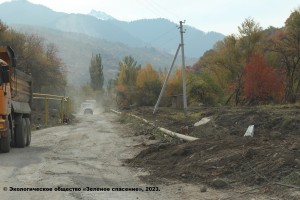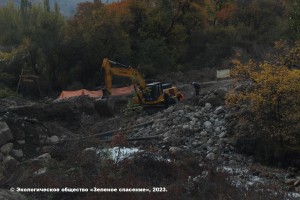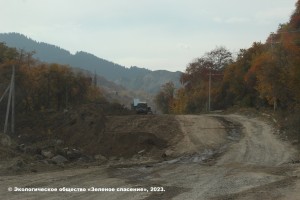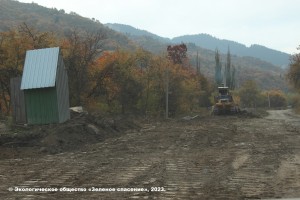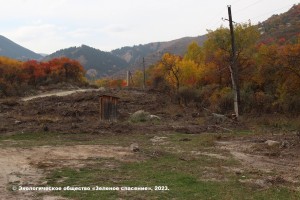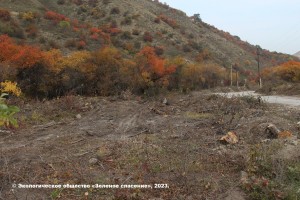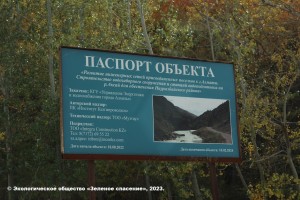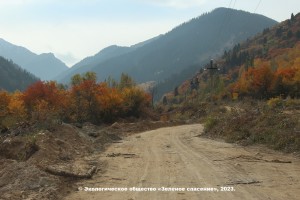The global economy is already so far above sustainable
levels that there is very little time left for the fantasy of an infinite globe.
Donella H Meadows; Jorgen Randers; Dennis L Meadows[1]
A city devouring itself
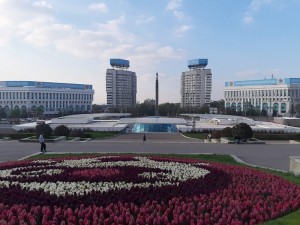 What does the construction of four new water intakes[2] for Almaty indicate? Firstly, that the city constantly lacks water. Secondly, that the ecological capacity of the territory has been exceeded and Almaty has reached the limits of its growth. If this urban development trend continues to dominate, then no new water intakes or wells will save the situation.
What does the construction of four new water intakes[2] for Almaty indicate? Firstly, that the city constantly lacks water. Secondly, that the ecological capacity of the territory has been exceeded and Almaty has reached the limits of its growth. If this urban development trend continues to dominate, then no new water intakes or wells will save the situation.
Last year, at a meeting with Almaty residents, the akim[3] publicly admitted: “I am forced to admit that today in the state land fund of the city there are no free land plots for the construction and expansion of social infrastructure, as well as places of leisure and public spaces. We will solve these problems exclusively through construction or extensions, or the purchase of buildings and land plots from private owners.”[4]
The population growth of Almaty, Astana and Chimkent is largely due to “internal migration from the regions.” “The number of residents of Astana has increased by 82.3% since 2012. If ten years ago 742 thousand people lived in the capital, then in 2023 there will be about 1.4 million citizens.
In Almaty, the situation is similar: over ten years the population has increased by more than 700 thousand people, amounting to almost 2.2 million people. In relative terms, this is plus 49.1%.”[5] About “60% of the increase comes from migration.”[6] Why do people strive to live in megacities? “Only Astana and Almaty have higher indicators of workers’ well-being than the country as a whole. […] Despite the inconveniences and hardships that residents of big cities are forced to put up with—long waits in traffic jams, queues, polluted air—for many migrants, the opportunities of megacities outweigh all the disadvantages.”[7] In other words, the city’s population is growing because of migration from disadvantaged areas of the country.
“Over the past eight years, the city’s area has doubled from 33.3 thousand hectares to 68.3 thousand hectares.”[8] How did it increase? Through the annexation of suburban settlements, vast fertile fields that fed the city for many decades, cutting down gardens, building water protection strips, transferring lands of specially protected natural areas into reserve lands! How much have fresh water reserves increased? How much cleaner has the air above us become? The official authorities are silent about this.
Almaty is firmly established among the cities in Kazakhstan with the most polluted air. Smog has been hanging over Almaty for more than 50 years. Two generations of Almaty residents were born and raised, inhaling a toxic mixture every day. Only the pre-smog generation of townspeople still remembers the freshness of the clear air, shady streets and parks, the crystal water of rivers and ditches. The youngest generation suffers from smog, allergies, bottled water, diseased trees, the incessant roar of thousands of cars, dense urban development, concreted riverbanks, and countless landfills. In a word, growth without end and without edge!
Despite the obvious evidence that the environmental load on the urban area is exceeded, we hear a new call as a recipe for breaking the environmental impasse: “The success of the future development of the city of Almaty is determined, first of all, by the sustainable growth of its economy, financial income and the active attraction of investments.”[9] Are development and growth synonymous? Very strange. Development and growth are different concepts.[10] Maybe our establishment doesn’t understand this or simply doesn’t know what to do with a city that is devouring itself?
Where to get water?
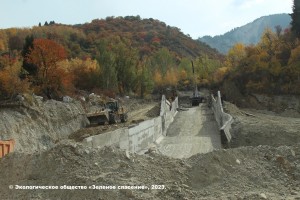 As stated above, the Almaty authorities intend to “sort out” the water shortage by building new water intakes. Where to get water? One of the main sources is the rivers of the Ile-Alatau National Park. Everything is “done” in the most primitive and destructive way by transferring his lands to the category of reserve lands.
As stated above, the Almaty authorities intend to “sort out” the water shortage by building new water intakes. Where to get water? One of the main sources is the rivers of the Ile-Alatau National Park. Everything is “done” in the most primitive and destructive way by transferring his lands to the category of reserve lands.
Paragraph 11 of Article 36 of the Environmental Code states: “In order to preserve and improve specially protected natural areas for these territories, taking into account their special environmental status, in accordance with this Code, more stringent environmental quality standards may be developed and approved than those established for throughout the territory of the Republic of Kazakhstan.”[11] However, this is a “dry theory,” but in practice… For some reason, not a single innovation comes to mind regarding the approval of more stringent environmental standards for national parks. Nevertheless, there are more than enough examples indicating the deterioration of the situation.
Aksai canyon. “According to the Decree of the Government of the Republic of Kazakhstan No.337 dated May 29, 2020 “On the transfer of lands of specially protected natural areas into reserve lands,” the lands of the RGU Ile-Alatau State National Nature Reserve” … with a total area of 16.6042 hectares were transferred from specially protected natural areas to the category of reserve lands of Karasai district of the Almaty region for the construction and operation of a water intake structure and a main pipeline on the Aksai River for water supply to the Nauryzbay district of Almaty.” [12]
By Government Decree No.808 of November 12, 2021, 5.69 hectares of land of the Ile-Alatau State National Park were transferred “to the category of reserve lands in the Karasai district of the Almaty region for the construction of a water intake structure on the Kargaly River for water supply to the Nauryzbay district of the city of Almaty!”
By Government Decree No.293 of May 16, 2019, 49.7306 hectares of land of the Ile-Alatau State National Park were transferred “from the category of lands of specially protected natural areas to the category of reserve lands for the construction of mudflow protection dams.” The same resolution says “2. The Akim of the city of Almaty, in accordance with the procedure established by the legislation of the Republic of Kazakhstan, ensures: …
2) preservation of objects of the natural reserve fund!” The whole city knows what the construction site in the Big Almaty Gorge has been turned into.
By Government Decree No.1408 of November 10, 2012, 29.4597 hectares of the Ile-Alatau SNNP were transferred to the category of reserve lands of the Karasai district of the Almaty region.
Recently, the Akimat of Almaty announced claims to 20,000 hectares of the Ile-Alatau National Park, with the aim of including them in the Medeu regional park.
In addition, this is not counting the territory of the national park, located within the administrative boundaries of the city, which the Akimat manages as if it were its own backyard!
The myth of compensatory landings
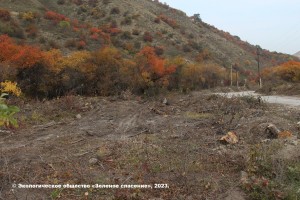 The areas of the national park transferred to the category of reserve lands are not wastelands. These are wild fruit and coniferous forests, ecological systems that have undergone only minor anthropogenic impact. But in order to “ensure conditions for construction activities, construction and installation work” in the Aksai canyon, “in accordance with the permission of the State Institution “Department of Housing and Communal Services, Passenger Transport of Highways and Housing Inspectorate of the Karasai District” dated 08/10/2023,” workers cut down 12,544 trees! Apparently, according to officials, cutting down trees does not affect the places where they grow and the state of natural ecological systems. It is enough to make compensatory plantings of trees, anywhere and anyhow, and you will instantly reproduce natural ecosystems
The areas of the national park transferred to the category of reserve lands are not wastelands. These are wild fruit and coniferous forests, ecological systems that have undergone only minor anthropogenic impact. But in order to “ensure conditions for construction activities, construction and installation work” in the Aksai canyon, “in accordance with the permission of the State Institution “Department of Housing and Communal Services, Passenger Transport of Highways and Housing Inspectorate of the Karasai District” dated 08/10/2023,” workers cut down 12,544 trees! Apparently, according to officials, cutting down trees does not affect the places where they grow and the state of natural ecological systems. It is enough to make compensatory plantings of trees, anywhere and anyhow, and you will instantly reproduce natural ecosystems
To realize this environmental miracle, the Department of Energy and Water Supply of the city of Almaty was given an order to carry out compensatory “restoration of trees and shrubs by planting seedlings of tree and shrub species in 10-fold size, as well as to carry out a full range of measures to protect, maintain and preserve forest plantations in the adjacent territory.”[13]
In accordance with the permit, the following felling included: birch, cherry, squat elm, rough elm, oak, Tien Shan spruce, willow, Norway maple, walnut, plum, Scots pine, sumac, white poplar, trembling poplar, pyramidal poplar, ash common, creeping juniper, barberry, hawthorn, viburnum, buckthorn, sea buckthorn, rowan, lilac, rose hip.
With a generous hand, they gave permission to proceed to cut down plants included in the Red Book of Kazakhstan—an illustrated list of rare and endangered species of plants and animals and plants included in the Red List of the International Union for Conservation of Nature. According to the permit, 1,028 apricots were cut down. Apricot—scientific name “common apricot” (Prunus armeniaca—synonym Armeniaca vulgaris) is included in the official “List of rare and endangered species of animals and plants”[14]—paragraph 117. 2345 apple trees were cut down (varieties not specified). This List includes wild varieties of apple trees: item 113—Niedzwetzkyana apple tree (Malus niedzwetzkyana); point 114—Sievers apple tree (Malus sieversii). Niedzwiecki apple and Sievers apple are classified as “endangered” and “vulnerable” species on the International Union for Conservation of Nature Red List.[15]
In accordance with paragraph 1 of Article 339 of the Criminal Code,[16] “Illegal… destruction of rare and endangered plant species… as well as destruction of their habitats is punishable by a fine in the amount of up to three thousand monthly calculation indices, or correctional labor in the same amount, or involvement in public works for a term of up to eight hundred hours, or restriction of freedom for a term of up to three years, or imprisonment for the same term, with confiscation of property, with deprivation of the right to hold certain positions or engage in certain activities for a period of up to five years.”
However, this is again just a “dry theory,” but in practice, you are once again convinced that our officials do not care. After all, it is at their “order” that trees are cut down “exclusively for people and for the sake of people,” and ecological systems are destroyed on the former lands of the national park, which provides us with vital benefits. What a touchingly fanatical concern for a person!
“Aquatic ecosystems in Kazakhstan are particularly vulnerable”
Are there no other ways to solve the problem? In 2022, the UN Development Program published a special publication for our country, “Simply on Climate Change. Handbook on adaptation to climate change in Kazakhstan!” [17]
What do the experts offer? First, they note, “aquatic ecosystems in Kazakhstan are particularly vulnerable.” Therefore, “it is necessary to change the entire system of state planning, the procedure for the development, implementation and financing of state and territorial programs taking into account climate change.”
Secondly, they emphasized the importance of implementing the following measures:
– “building nature-based infrastructure for flood prevention, including the expansion and restoration of forests and wetlands;
– restriction of economic activity in areas exposed to climate risks in order to preserve and restore vegetation cover in watersheds in order to reduce the dangers of mudflows and floods;”
– “restoration and preservation of forest ecosystems, increasing forest cover and forest belts to regulate and prevent flooding and flood phenomena;”
– “development of networks of protected natural areas and eco-corridors to protect the migrations of animals and birds and preserve biodiversity;”
– “increasing forest cover in drainage areas in river basins and reforestation in areas where river flow dissipates.” “For example, forests in river basins significantly reduce the severity and speed of flash floods. But for this it is necessary that at least 30% of the river basin be covered with forest.”[18]
Thirdly, it is necessary to reduce consumption!
“Forests and trees are integral components of the water cycle.”[19] Destruction of forests, especially along riverbanks, causes irreparable harm to forest and aquatic ecosystems.
If you compare the recommendations of the UN Development Program with the “activities” in the Aksai canyon, it becomes obvious that they mean absolutely nothing to officials and developers. The forest is being cut down, and the habitats of rare and endangered species are being destroyed, and the mountain slopes are being destroyed, and water protection zones are being built up! What can we expect as a result other than a deterioration in the environmental situation and an increase in water scarcity?
Vicious circle
We are caught in a vicious circle. The lack of state environmental policy in the context of the global environmental crisis and the predatory exploitation of vital resources, the lack of which is becoming more obvious every day, lead to a deterioration in the quality of life! Violations of human rights to live in an environment conducive to health and well-being have become the norm.
Uncontrolled urbanization is creating more and more environmental problems. Solving them by plugging the holes and applying patches where they are torn temporarily relieves the tension. “By indiscriminately extracting water resources, damaging nature and biodiversity, polluting both Earth and space while cutting down options to deal with disasters, human actions introduces new risks and amplifying existing ones.”[20]
By sacrificing the ecological systems of specially protected natural areas, their forests and mountains, to economic growth, “it is as though we are approaching a cliff that we cannot see clearly ahead of us, and once we fall off the cliff, we can’t easily go back,”[21]
“Forests are vital for water security: forest and mountain ecosystems serve as source areas for more than 75 percent renewable water supply, providing water to over half of the world’s population.”[22]
The downside of economic growth is increased water scarcity, increased disease, increased waste, increased poverty and unsustainable development.
P.S. The Ecological Society “Green Salvation” sent an appeal to the Committee on Ecology and Natural Resources Management of the Mazhilis of Parliament. It proposes, in accordance with paragraph 11 of Article 36 of the Environmental Code, to develop and approve more stringent environmental quality standards for specially protected natural areas than those established for the entire territory of the Republic of Kazakhstan. According to the Ecological Society, it is first necessary to introduce stricter environmental standards for specially protected mountain and forest areas.
The Ecological Society sent an appeal to the prosecutor’s office of the Almaty region with a request to verify compliance with the law when issuing permits for cutting down rare and endangered plant species of the Republic of Kazakhstan and plants included in the Red List of the International Union for Conservation of Nature.
© Ecological Society “Green Salvation,” 2023.
[1] D.H.Meadows; J.Randers; D.L.Meadows. Limits to Growth: The 30-Year Update.—London, Earthscan, 2006, p.12.
[2] Almaty will build four new water intakes, August 19, 2023: https://kapital.kz/economic/118366/v-almaty-postroyat-chetyre-novykh-vodozabora.html.
[3] Akim— head of local executive authority.
[4] Report of Almaty akim E. Dosayev from a meeting with the population of Bostandyk district, April 14, 2022: https://www.gov.kz/memleket/entities/almaty/press/article/details/82534?lang=ru.
[5] Cities are not rubber: what has uncontrolled urbanization led to in Kazakhstan? September 19, 2023: https://finprom.kz/ru/article/goroda-ne-rezinovye-k-chemu-v-kazahstane-privela-beskontrolnaya-urbanizaciya.
[6] Almaty is a global city for people. Main priorities of the Almaty Development Plan until 2025 and medium-term prospects until 2030. June 2022, p.3.
[7] Cities are not rubber…
[8] Almaty city development program until 2025 and medium-term prospects until 2030. Almaty, 2022, p.17: https://www.gov.kz/memleket/entities/almaty/documents/details/344101?lang=ru.
[9] Almaty city development program until 2025…, p.72.
[10] Donella Meadows, Dennis Meadows, Jørgen Randers. Beyond the Limits, Chelsea Green Publishing, 1992, p. xix.
[11] Environmental Code (as amended and supplemented as of September 5, 2023).
[12] Response of the RGU “Ile-Alatau State National Natural Park” dated September 13 (Ref. No. ЗТ-2023-01714512) to the letter of the Ecological Society “Green Salvation” dated August 31, 2023 (Ref. No. 061).
[13] Response of the RGU “Ile-Alatau State National Natural Park”….
[14] “List of rare and endangered species of animals and plants,” approved by government decree of October 31, 2006 №1034: https://adilet.zan.kz/rus/docs/P060001034_.
[15] The IUCN Red List of Threatened Species:
- Malus sieversii: https://www.iucnredlist.org/species/32363/9693009;
- Malus niedzwetzkyana: https://www.iucnredlist.org/species/63477/12681555;
- Prunus armeniaca: https://www.iucnredlist.org/species/50134200/50134213#assessment-information.
[16] Criminal Code of July 3, 2014 No. 226-V (with amendments and additions as of September 12, 2023: https://adilet.zan.kz/rus/docs/K1400000226.
[17] Just about climate change. Handbook on Climate Change Adaptation in Kazakhstan, UNDP, 2022: https://www.undp.org/sites/g/files/zskgke326/files/migration/kz/e0520a6f85cf55f851ea4ea57827e012f403cc63b70f1c3d199a390d5b9c29ff.pdf.
[18] Just about climate change. … pp.10, 16, 25, 29-30, 47.
[19] A guide to forest-water management. FAO, IUFRO and USDA. 2021. FAO Forestry Paper No. 185. Rome, р.3: https://doi.org/10.4060/cb6473en.
[20] ‘Tipping points’ of risk pose new threats, UN report warns, October 25, 2023: https://news.un.org/en/story/2023/10/1142807/
[21] Ibidem.
[22] A guide to forest-water management, р.3.







